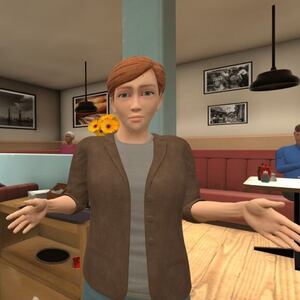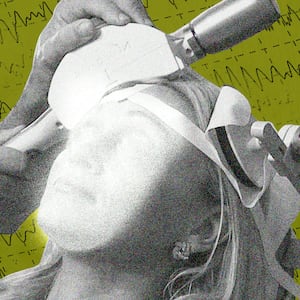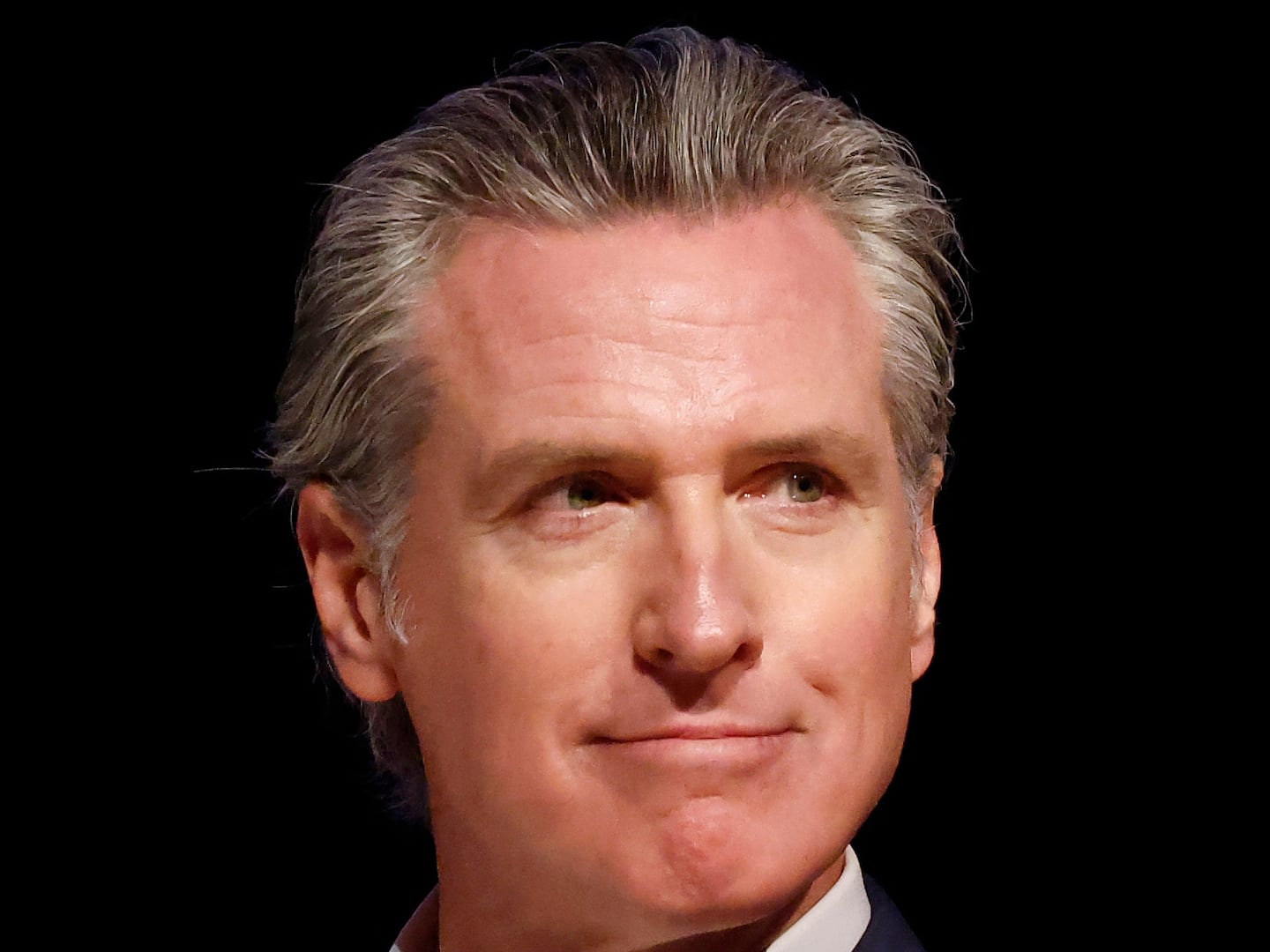Had I known I would be facing off in a virtual reality competition, I would’ve worn better shoes. Instead, I tried my hardest not to let my black pleather boots slip from the pedals of a portable exercise bike while attempting to kick Alex Maugeri’s ass at a two-player game in Rendever’s Somerville, Massachusetts office. While pedaling furiously along a wooden boardwalk, we waved our controllers wildly to pop balloons that only we could see in our VR headsets. A lighthouse towered above a finish line at the end of the boardwalk, and I pedaled faster, but Maugeri still raced ahead.
In a last-ditch effort to tilt the odds in my favor, Rendever’s CEO Kyle Rand turned Maugeri’s bike’s resistance to the max—but instead of giving me the leg up, it stopped my virtual bike in its tracks. We had mixed up the controls: I had been pedaling for Maugeri, and he for me. When we discovered the error, the room dissolved into giggles, and Maugeri and I raised our VR headsets to our foreheads.
“I’m at the finish line,” Maugeri said, incredulously.
“Yeah, you’re welcome,” I replied, continuing to pedal even though the game had ended.
“That's what we see happen all the time,” Rand said, bringing us back to task. “Residents just keep going,” pedaling long after the competition has ended. “We’re working on an infinite mode.”
I was here to try out a demo of RendeverFit, a new VR platform the company offers to senior living communities. Exercise improves all kinds of physical and mental benchmarks for older residents, but that’s only part of the vision Rand has for Rendever’s VR platform. The company partners with senior living facilities to offer solo and group experiences, like virtual trips abroad, as well as customized “reminiscence therapy” where residents and their loved ones can upload multimedia from their past and experience it in VR together.
“We're building a future in which we think about aging as a connected experience,” Rand told The Daily Beast. “That means you can work out in VR, you can learn, you can spend time with family members, you can go and experience the world. It's all empowered through VR.”
Virtual reality has quickly moved past its reputation as a niche video game console that nauseated its users (literally). Today’s VR is sleek, with capabilities once considered inconceivable—fully realized avatars that emote and cry; naturalistic scenery; and the ability to interact exclusively with one’s bare hands, no controllers involved. Proponents see a household use for VR, whether in the form of the so-called (and still ill-defined) “metaverse,” or simply as a way to connect with family and work on yourself.
Some researchers have found the technology to be especially potent at solving mental health issues like anxiety, addiction, and social isolation. Today’s virtual reality startups are in the game of creating and perfecting illusions to help users cope with reality, not disconnect from it.
These experiences are coming to homes and hospitals sooner than we might think. The Food and Drug Administration approved the first use of VR for medical treatment last November: a therapy for chronic lower back pain made by startup AppliedVR. Since then, over a dozen more clinical trials are in various stages of planning. A recent report predicts that the market for VR in health care will jump to $9.7 billion by 2027, a 350 percent increase from where it stands today. The questions on experts’ minds now are how VR can go beyond its potential, and how virtual reality can leave the staging area and become a real, valuable treatment for people in need.
Nicole Caputo, the senior director of experience and innovation at the Colorado-based health care system UCHealth, still gets choked up talking about the time she surprised a pancreatic cancer patient with front-row seats to the Colorado Symphony. The woman had been receiving chemotherapy treatments at one of UCHealth’s clinics long enough that she had cycled through the available classical music-related VR experiences, provided courtesy of Rendever. So the hospital staff and Rendever decided to partner with the Symphony and record them playing music by Vivaldi at Red Rocks Amphitheater, just outside Denver.
During the woman’s next treatment, UCHealth staff launched her custom VR experience from a tablet and waited. When the video had ended, the woman removed her headset and joyfully told the clinicians: “Music is my medicine.”
“She literally said, ‘That is my medicine,’ while getting life-saving chemotherapy,” Caputo recalled. “For one piece of technology to be able to do that to your brain, it's game-changing for health care.”
According to Caputo, patients at UCHealth are given the option of putting on a headset during wound redressings, post-surgery recovery, and vaccinations, as a way to lessen their feelings of pain and anxiety. “We're trying to look at VR as a standard of care,” she said. “I get super excited about it because I haven't seen a replacement [for what it does].”
UCHealth isn’t unique in its interest in VR for patients. Boston-based startup, Rocket VR Health, is testing controller-free meditation in virtual reality with cancer patients at Massachusetts General Hospital.
Caputo recounted how the head of a COVID-19 vaccination clinic kept a headset on hand for patients who were nervous about needles or the procedure. One young woman came into the clinic determined to get vaccinated, having unsuccessfully tried therapy and medication to treat her needle phobia. Before her appointment, health care workers let her try out the technology; during the shot, she played a balloon-popping game similar to the one I played. Afterwards, she told clinicians she hadn’t even felt the shot.
“It gives you chills, because it's simple, and it's something we can deliver to everybody,” Caputo said. “I think that health care is going to be the vehicle that takes VR mainstream.”
Health care providers are pleasantly surprised by what VR can do for mental health, vindicating researchers who have been in the space for decades. In the ‘90s, a group of University of Washington researchers created SpiderWorld, a three-dimensional spider-filled landscape that burn victims and patients with arachnophobia could navigate while wearing a headset and manipulating a joystick. In a preliminary case study published in the journal Pain in 2000, researchers asked two patients with severe burns to rate their pain, anxiety, and other feelings while they received wound care and either played MarioKart and Wave Race on a Nintendo 64—or entered into SpiderWorld, where they could “‘physically’ touch the furry body of a virtual Guyana bird-eating tarantula with wiggling legs,” according to the study.

A screenshot of the VR Spiderworld program.
HITLAB/University of WashingtonBoth patients reported feeling less pain while playing in VR versus playing standard video games. One even said that he spent 2 percent of his time in SpiderWorld thinking about the pain, compared to 95 percent while playing the Nintendo.
Spiders, however, were nowhere in sight when I sampled an upcoming mental health offering to cancer patients made by Rocket VR Health. Once the company’s CEO, Sid Desai, set me up with a headset and started a demo of his company’s breathing and meditation platform, he might as well have left me alone in the downtown Boston building.
I was transported to an animated beach, where a sailboat lazily floated across the horizon, and small crabs scuttled on the sand near my periphery. An ASMR-like voice instructed me to breathe in, hold my breath, and exhale in time with an expanding and contracting circle. I had chosen “calm” breathing from a selection including “acceptance” and “compassion.” Though I didn’t necessarily feel calmer, I did notice that I was able to breathe in time with the instructions, much slower than I was used to. In VR, it didn’t feel like I was holding my breath.

The “breathe in” prompt for Rocket VR Health’s meditation program.
Jeff Kim/Rocket VR HealthAt least that part of my experience is a common one, Desai said.
“People have a stronger adherence to finishing a lot of these treatments when they're fully immersed in a space,” he said. “We want this to be like training wheels on your bike” that over time can be removed, allowing patients to re-engage with communities and take practiced skills into their lives. Rocket VR Health wants to eventually provide patients with VR modules to teach meditation and breathwork, educate them about their medical conditions, and facilitate individual and group therapy.
It’s unlikely that VR will outright replace some tried-and-true methods of mental health treatment. But early research suggests that VR simulates reality better than any technology before it, creating a kind of sandbox for the mind to work through its challenges without the same fear and risks of real-world consequences.
“If you want to change a cognitive process or an emotional reaction to a stimulus, like we do for addiction or post-traumatic stress, you need to be able to activate it on demand,” Walter Greenleaf, a neuroscientist at Stanford University’s Virtual Human Interaction Lab, told The Daily Beast. “That's where VR is particularly excellent.”

A screenshot of Rocket VR Health’s meditation program.
Rocket VR HealthStudies have borne this out, showing that a VR rollercoaster ride produces some of the same brain activity as the real thing. Group VR, like what Rendever offers to senior care facilities and families, might even be used as a tool for ego dissolution comparable to psychedelic therapy, as recent research suggests.
The key seems to be the immersive experience of VR, which takes up a user’s entire field of vision, Beth Darnall, a Stanford University pain scientist and the chief science adviser at AppliedVR, told The Daily Beast. The same principle, she said, was at play when she used to prescribe mirror therapy to patients with phantom limb pains.
“Imagine my right leg is amputated, but I still feel pain on my foot and my ankle—I can take a closet-sized mirror and place it between my legs in such a way that when I look down, I see the illusion of having a fully intact right leg,” she said. “We see that for many people that confers relief for them.”
VR is just the same: “When I put on the headset, it’s 360 immersive, and it is so engaging and compelling,” Darnall said. “You really, truly feel like you're there.”
To convince skeptics of the power of immersion, AppliedVR’s CEO used to ask users to try a simulation where headsets would take them to the top of a skyscraper with a 500 foot drop—with only a gate separating them from falling. When the gate would open, users would be asked to take a step forward. Many would refuse, even if they rationally knew they would not fall to their death.
Not everyone loves the skyscraper test, though.
“They love to traumatize people that way, and they try to justify it by making the point that we can create an on-demand emotional experience of fear,” Greenleaf said. “That's great, but can’t they create an emotional experience of joy?”
VR has a PR problem, said Greenleaf. Today’s headsets, like Meta’s Oculus Quest 2, have proved to be a hit for more affluent gamers, but the perception and design of VR as a gamer’s tool may alienate the people who could benefit from it therapeutically—particularly the elderly or disabled.
Moreover, therapeutic VR is most effective when the digital environments look, well, real. And the technology is still working to meet that goal. During my meeting with Jeff Kim, Rocket VR Health’s creative director, we walked through VR environments designed specifically for group meetings, lectures, and therapy sessions. Yet Kim’s online avatar had the blocky, cartoonish look of the Mii figures first introduced 15 years ago on the Nintendo Wii. He said that even if the technology advances to render realistic backgrounds, the avatars likely won’t change much.
But that might just be a limitation we have to accept. “There are some other avatars that have a more realistic texture, but if you're just a little bit off, then it looks like a corpse,” said Kim.
Ironically, the rapid advancement of VR may be holding back the technology for clinical application. Apart from a handful of big players including AppliedVR that have sponsored large-scale clinical trials, worries about evolving hardware and software have put a damper on the kind of testing that a finished medical device would receive.
“There are people who are doing clinical trials, but they're on last year's technology, and they're small datasets,” Greenleaf said. “To use the same rigor that we use for other products in the medical arena, it's going to take a while before we have the larger clinical trials.”
At Rendever’s office, Maugeri and Rand wanted to show me the kind of experience that can distract cancer patients from chemotherapy and that senior care facility residents can engage in together or with family members. I chose a journey up Mount Everest, shot by a professional filmmaker for VR viewing. I couldn’t move around, unlike some of the other VR experiences, but instead I swiveled my head and considered the immense feat of climbing Everest and schlepping the equipment to film it in VR, too.

I asked the pair if residents ever feel regret over being able to see Everest, Paris, or even the zoo in VR but not in real life. More often, it’s the opposite, Maugeri explained—residents say the technology gives them access to parts of the world they thought had become closed off to them forever.
Strangely enough, I actually felt like the limitations and glitchy quirks of these simulations endeared me to the experience. A glossier version of VR would be bug-free, but it would also lack the goofy qualities that make it such a human experience—and one worth sharing. Maybe that’s something that can’t be programmed.
Rand emphasized that for him, the experiences are only as useful as their outcomes: “It's the conversation that happens after; it’s a smile as you walk down the hall because you just climbed Everest with that person, and asking them to get coffee afterward.”
This story is part of a series on exploring new innovations in mental health technologies and treatment. Read the other stories in our package here:








